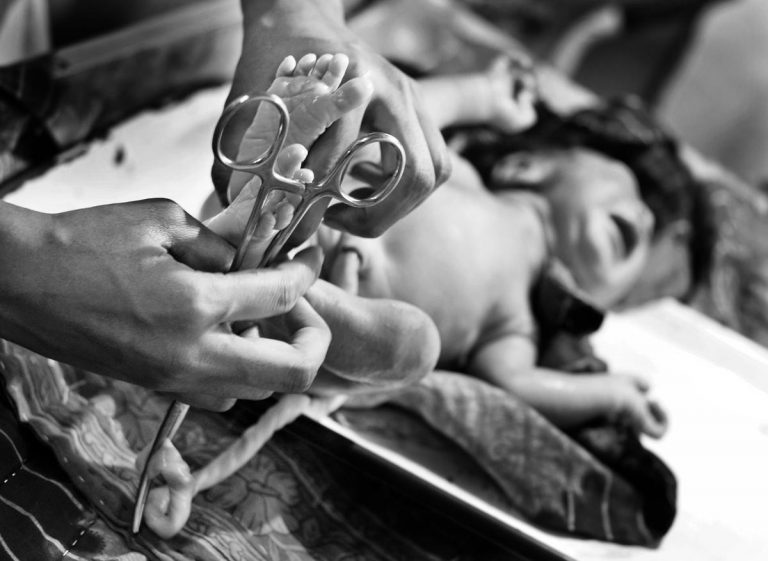The global public health agenda spotlight is increasingly focused on reducing preventable newborn deaths. Skilled care at birth and delivery in a health facility equipped with life-saving medical technologies is a clear path to prevention. However, many women continue to deliver at home, impeded by lack of access to a health facility, concerns of sub-par quality at nearby facilities, or financial constraints where healthcare is not well subsidized.
Steps can be taken immediately after birth that may improve the chance of newborn survival and can be applied with nominal costs. Keeping infants warm—thermal care—and preventing infection where the umbilical cord was cut—hygienic cord care—are two key practices.
IMPROVING OUR ASSESSMENT OF NEWBORN CARE PRACTICES
The Demographic Health Survey (DHS) Program, which administers household-based surveys, undertook efforts in 2014 in order to improve the assessment of newborn care practices. They worked with the recommendations from the Newborn Care Technical Working Group to:
- Develop an optional “Newborn Care Module” with a standardized set of questions assessing newborn care. This module collects information on drying, bathing, cord cutting and cord care including the application of chlorhexidine.
- Add questions to the core questionnaire for DHS Phase VII regarding care at time of birth, pre and post-discharge contacts for mothers and newborns, content of postnatal care for newborns, and other essential newborn care practices (immediate skin-to-skin, early initiation of breastfeeding).
Questions related to thermal care and cord care have been included in some DHS surveys since 2003, a total of 16 surveys conducted between 2003-2016 in 10 countries: Bangladesh, Ethiopia, Ghana, India, Morocco, Nepal, Nigeria, Pakistan, Sierra Leone, and Timor Leste.
AN ANALYSIS OF THE DATA
A Journal of Global Health Collection on Measuring Coverage of Essential Maternal and Newborn Care Interventions: An Unfinished Agenda issued a call for action to use these data to track progress over time and make comparisons between countries in order to assess whether newborns are receiving life–saving interventions, prompting The DHS Program to conduct further analyses.
In September 2018, the DHS published a study examining the associations of thermal and cord care practices with newborn mortality. The study sought to explore: 1) what’s been happening with these practices over time; 2) is there an association between these practices and newborn deaths among home births; and 3) what factors predict these practices among home births? The analysis includes an in-depth exploration of newborn care in 3 South Asian countries: Bangladesh, India, and Nepal.
KEY FINDINGS FROM THE DATA
- In countries with more than one survey available, coverage of recommended thermal care and hygienic cord care practices increased over time, with more frequent application among facility births than home births.
- Among home births in South Asia, skilled care during pregnancy and birth increased the odds of receiving the recommended practices.
- In Bangladesh and Nepal, application of an antiseptic (chlorhexidine or an unspecified antibiotic or antiseptic) to the cord was highly protective against newborn mortality compared with dry cord care.
- Among newborns who died, there was a high proportion of missing responses regarding recommended behaviors.
IMPLICATIONS OF THE FINDINGS
These findings highlight the importance of cord care in preventing newborn mortality and the importance of skilled care during pregnancy and birth for the implementation of recommended practices. Although thermal care did not predict newborn survival, sample size and missing cases limited the analyses. The findings also suggest that the recall or reporting of details around the traumatic event of newborn death may be incomplete.
Harmonizing responses across surveys allowed us to better understand utilization of recommended newborn care practices over time, which have mostly increased. However, countries continue to replicate questions from older surveys rather than adopting the newborn care module, which became available as of mid-2016. Further, although the DHS has only recently asked these questions of women delivering in health facilities, there is still need for improvement and for investigations of newborn care in health facilities, which will require new efforts in data collection and analysis. Countries can aid these efforts by including the optional newborn module when implementing their household surveys and consider conducting the DHS’s Service Provision Assessment Survey (SPA) of health facilities as a means to assess service quality.
The newborn module can be found on the DHS website here and SPA surveys here.
For more findings and details on this research, find the report here.
A peer-reviewed article based on the DHS report on thermal care and umbilical cord care was published in July 2019, and can be found here.
